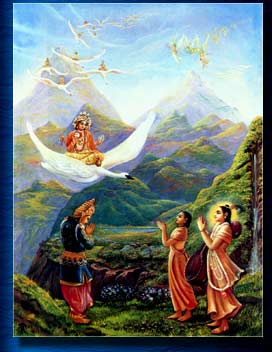
About the College | Schools & Admissions | Contact Us
Home | Resources | Donors | Volunteers | Search
The Vedas have six appendices called the shad-vedangas, the six limbs of the Vedas. They are: siksa, chanda, nirukta, vyakarana, kalpana, and jyotish.
Siksa is the science of proper articulation and pronunciation of the Vedic phonemes (sounds). Siksa is essential because mantras are precise sound formulas that must be executed properly if the desired result is to manifest, [see creation of Vrtasura, Srimad Bhagavatam 6th canto to see what happens if mantras not chanted properly].
Chanda is the science of poetic meter; in the Vedas there are eleven chandas such as Gayatri, Usnik, Anustup, etc. (SB 11.21.41).
Nirukta is the science of etymology and lexicology; a famous nirukta was compiled by Yaska.
Vyakarana is the science of grammar. In ancient times Panini's Astadhyayi replaced all other works on the subject because of his masterful presentation and conciseness; it is still the standard. Jiva Goswami wrote his own vyakarana called Harinamamrta Vyakarana, it isn't very concise but has the edifying quality of glorifying Sri Krsna.
Kalpana is the science of rituals (viddhi).
Jyotish is the science of astronomy and astrology. The Yajur and Rig Vedas have sections attached to them dealing with astronomy, whereas the Atharva Veda has a section dealing with Astrology. Aside from the Vedas, many Rishis such as Parasara, Garga, Narada, Sukadeva, Brghu, etc., wrote on this science and preserved it in their sampradayas.
The first pair of angas: siksa and chanda teach us how to speak the Veda. The second pair: nirukta and vyakarana teach us how to understand the meaning of the Veda. While the third pair: kalpana and jyotish teach how to use the Veda.
Each vedanga is related to a bodily limb. Jyotish is given the epithet vedachaksus, "the eye of the Veda," because it allows us to see through opaque time and to understand how the gunas are working.
In the Vedas great stress was made on performing sacrifices and other observances at the correct time in order that such sacrifices and observances bear fruit; this is one area of jurisdiction of the vedanga jyotish. This of course is the same principle that we presently follow by observing the Vaisnava Calendar. We like to observe Krsna Janmastami on the correct day, and we are careful to rigidly follow ekadasi. These and other pancanga (Bengali-panjika) calculations are astronomical in nature.
The astrological side is also important. Anyone who traveled with Srila Prabhupada was aware that he refused to travel on Thursday afternoons. Why? Because he learned from Srila Bhaktisiddhanta that Thursday afternoons were ruled by the Rahukalam, Barbela (in Sanskrit: vara-vela) and Kalabela (kala-vela), inauspicious times under negative influence.
In both instances above observing certain activities at certain times and avoiding activities at other times are two sides of the same coin. Namely understanding the nature of time through the motion of the planets.
